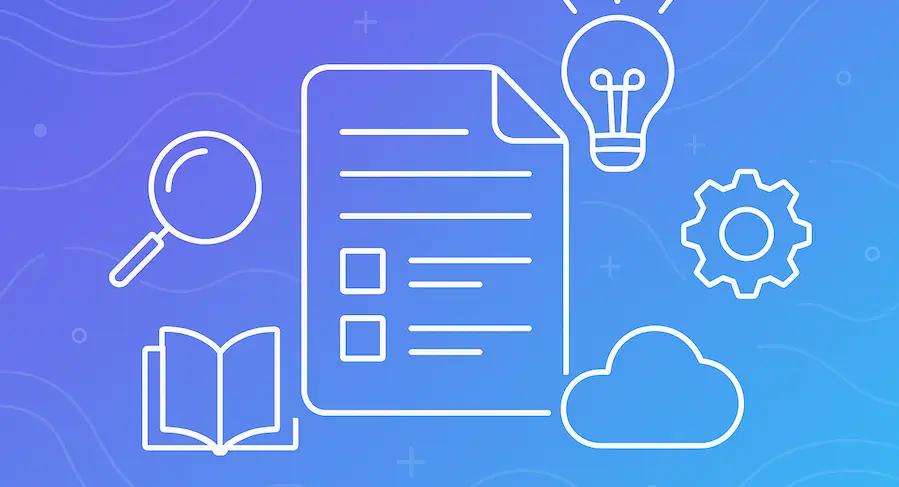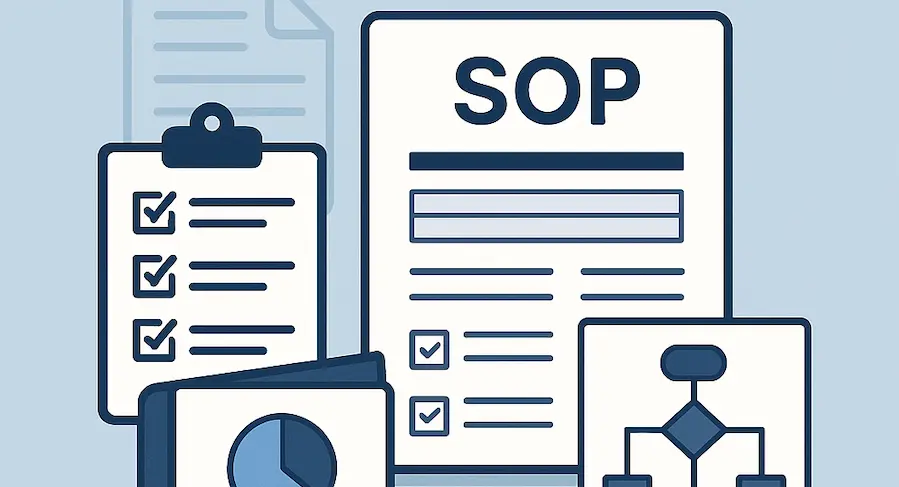
According to recent research, 65% of people who switched jobs haven't returned to the same industry.
What does that mean for you as a business owner or HR manager?
It means that you probably won't be able to find new employees with the same set of skills and background as your previous employees, which could complicate the employee onboarding process.
Companies are not only struggling to attract the right talent but also to provide adequate training to new staff. And the main reason for this could be the lack of documented processes in your organization.
Process documentation enables you to standardize business processes and operations, making sure that everyone is on the same page and can perform them at the same level of quality.
The good news is that business process documentation doesn't have to be complicated, and automated software solutions can streamline it. Keep reading to discover how.
What is business process documentation?
Business process documentation is the practice of creating detailed process documentation by outlining and describing procedures and activities within your company.
Well-documented business processes simplify complex procedures and provide employees with detailed instructions on how to do different tasks.
This systematic approach has many benefits, from saving time and money to creating a knowledge base. It also ensures normal process flow no matter what the external circumstances.
Business process documentation: examples
Process documentation comes in different formats, depending on who it is intended for – new employees, managers etc. All these formats are easy to create with quality SOP software.
Here are the most common business process documentation examples:
- Standard operating procedures (SOPs)
- How-to guides
- Training manuals
- Employee onboarding guides
- Visual process maps
- Process flowchart
- Performance review guidelines
- Customer support guides
- Tutorials
- FAQ for customers
Of course, the type of process documents will also depend on your industry, so make sure to choose a flexible and customizable tool that comes with different templates. There are multiple platforms that can help you, and in this article, you'll learn how to create a process document from scratch.
Why do you need business process documentation?
Detailed documentation benefits everyone, from employees and their managers to satisfied clients.
According to Statista, 54% of employees say that the most significant benefit of digital document processes is improving employee collaboration, while 47% say that it increases customer satisfaction.
Here are some other benefits of process documentation:
- It helps you standardize company processes
- It improves employee productivity
- It saves your employees a lot of time, enabling them to focus on non-admin tasks
- It helps to identify bottlenecks in the process
- It makes it easier to delegate tasks and responsibilities
- It's the best way to preserve organizational knowledge
- It improves the onboarding process and employee training
- It helps you to implement new tools faster
- It alleviates risks and minimizes errors
Business process documentation: how-to guide with MagicHow
Our process documentation software enables you to automate the whole process and saves you a lot of valuable time. Here's a step-by-step guide on how to document processes in your organization.
Define the scope, goals and audience

Before you start with process mapping, you may want to have a quick brainstorming session with your team members, especially those holding process roles.
Start by identifying the process's desired outcome and describing its purpose and primary goal.
If the process is complicated, you can break it down into smaller process objectives and milestones, making it easier to track progress.
Then, think about who the target audience is (new employees, executives, mentees etc.) and make sure to adjust language and style accordingly so that everyone can understand it.
You should also consider the equipment and resources you might need for completing this process to make sure your team members are well-prepared to execute all process tasks.
Finally, think about any key stakeholders involved and don't forget to mention them.
Create an outline
Documenting a process starts with creating a framework, an outline. Some may consider this step a waste of time, but it'll actually save you a lot of time in the long run because it enables you to see the bigger picture and identify process steps.
You can think of an outline as a business process documentation template or simply a list of things you want to include in the document.
Start with a brief description and overview. Include a quick summary of the entire process and explain what your team members will need to perform an action.
Here are other things that shouldn't be missing:
- Step-by-step instructions
- Resources
- Glossary explaining specific terminology
- FAQ section
- Process outputs or the desired results
It would be great if you could also add some visual aids such as pictures, screenshots, process flowcharts etc.
Use business process documentation software & tools

Although you could do this manually, using business process documentation tools is the quickest and most reliable way to ensure the success of your workflows.
MagicHow is one of the best and easiest tools for creating process documentation. You can use our AI-powered tool to create all types of business documents, from step-by-step guides, instructions, tutorials and manuals to many others.
It has an intuitive, user-friendly interface, meaning you don't need to be an expert to use this platform.
Our tool is mostly used in the following industries:
- HR
- Customer support
- Sales
- E-commerce
- Education
- Tourism
- Transportation
- Healthcare
- Entertainment
- IT
We have a specific process flow for the most popular industries that you can customize according to your needs.
Apart from using MagicHow for process documentation, you can also use it to accelerate and simplify the onboarding process, implement new tools and enrich your knowledge base with all kinds of tutorials.
Want to learn how to get the most out of MagicHow and similar business tools? Check out business process documentation best practices.
Install the software
You have the flexibility to choose whether you want to use MagicHow on your browser or desktop. Whatever option you choose, the installation process is remarkably simple and quick.
The browser version is compatible with all major search engines, including Chrome, Firefox, Edge and Safari.
The freedom to choose not only simplifies installation but also empowers you to seamlessly sync and create manuals on any device you prefer.
Perform and record the process you want to document
The best thing about MagicHow is that you don't have to document the process steps yourself.
All you have to do is press the recording button and perform a particular process as usual.
Our tool will record and take screenshots during the entire process and then split them into logical steps or smaller tasks.

There you have it! Now, you not only have a detailed description but also visual aids making it easier to follow and understand.
Of course, you can now edit and customize your process document with as much detail as you want.
Customize your process documentation
With our numerous customization features, you can be creative and enrich your documents by adding company branding. Tailor your manuals to reflect your brand identity, making the documentation process not only functional but representative of your company.
Here's what you can do:
- Customize the style (colors, font etc.)
- Blur sensitive data to enhance privacy and security
- Add titles and descriptions for every step
- Crop pictures
- Add your logo to screenshots
- Replace slides
- Merge multiple slides into one
Share your documents

The primary purpose of documenting processes is to boost collaboration and productivity and to do so, you should make your documents easily shareable.
That's why our process documentation tool offers you a wide range of sharing options to choose from, depending on the technical skills of your employees:
- Simply sending a link to your process documents
- Saving or exporting a guide or a manual as a PDF document
- Copying a guide as HTML or Markdown to post it on third-party websites, like wikis
- Embedding a guide in Notion, Confluence, Zendesk, Webflow or any other tool you might be using
Ask for feedback and update regularly

Finally, every piece of writing, be it a tutorial or a new hire training manual, must be reviewed and requires continuous improvement.
That means that after some time, you'll have to ask your peers or supervisors to provide you with feedback, positive or negative, on whether a specific document is helpful and whether you should change or add something.
It's also essential to monitor your industry trends and changes to make sure your processes stay compliant and to keep your competitive advantage.
You should do this regularly, especially in fast-paced industries where processes, rules and regulations are changing often.
At MagicHow, we value continuous improvement, so we've made it easy to edit and customize your documents, even after publishing them.
Business process documentation: best practices
Here are a few additional tips that will help you document and standardize your business operations and create user-friendly guidelines:
- Keep it simple: Process documentation serves to simplify complex processes, so do not overcomplicate things.
- Use clear and concise language: Your process documents should always be easy to read and as concise as possible. Different people will use the process document, so the terminology should be familiar to the document's intended audience.
- Make it skimmable: Add a lot of headings and short paragraphs, making it easier for your employees to skim the document when they just want to check some information quickly.
- Use a consistent format: Using documentation templates could be the key to consistency. You can create your own templates or use the existing ones and customize them.
- Provide examples: When documenting processes, illustrate them with a lot of examples, making it easier for people to understand.
- Use visual aids: Since many people are visual learners, having diagrams, flowcharts and videos can effectively illustrate some complex processes and, therefore, facilitate learning and understanding.
- Make it shareable: Instead of storing your files locally and making them inaccessible to external stakeholders, try using a centralized storage repository. It's easily accessible, and your team can make changes to process documents on the go.
- Learn to prioritize: Don't be overwhelmed if there are many processes you need to document. Identify the process that is the most important and could have a big impact on other processes and start from there.
Conclusion
With business processes getting more complex each day, creating proper documentation for your business is no longer optional but necessary to standardize business procedures and scale your business by hiring new people.
The only question is: how are you going to do it? You have two options:
- Take a traditional route and have one person responsible for creating everything manually
- Benefit from an AI-powered tool like MagicHow and let it automate the whole process for you, saving you time and resources
With our tool, everyone can document internal processes from their department, even if they're not that tech-savvy.
Furthermore, our tool comes with some advanced options such as process recording, customization and various templates for every situation.
Sign up today and see how we can help you create and streamline business process documentation.


